Addressing Specific Audit Situations in Auditing and Assurance in Australia
VerifiedAdded on 2022/12/27
|16
|4293
|49
AI Summary
This memo discusses the identification of potential audit risks and the corresponding audit procedures to address them in the context of auditing and assurance in Australia. It also highlights the weaknesses in the internal control system and suggests audit procedures to mitigate these risks. The memo focuses on specific financial ratios and their analysis, such as current ratio, quick assets ratio, return on equity, return on assets, gross margin, marketing expenses, and more.
Contribute Materials
Your contribution can guide someone’s learning journey. Share your
documents today.
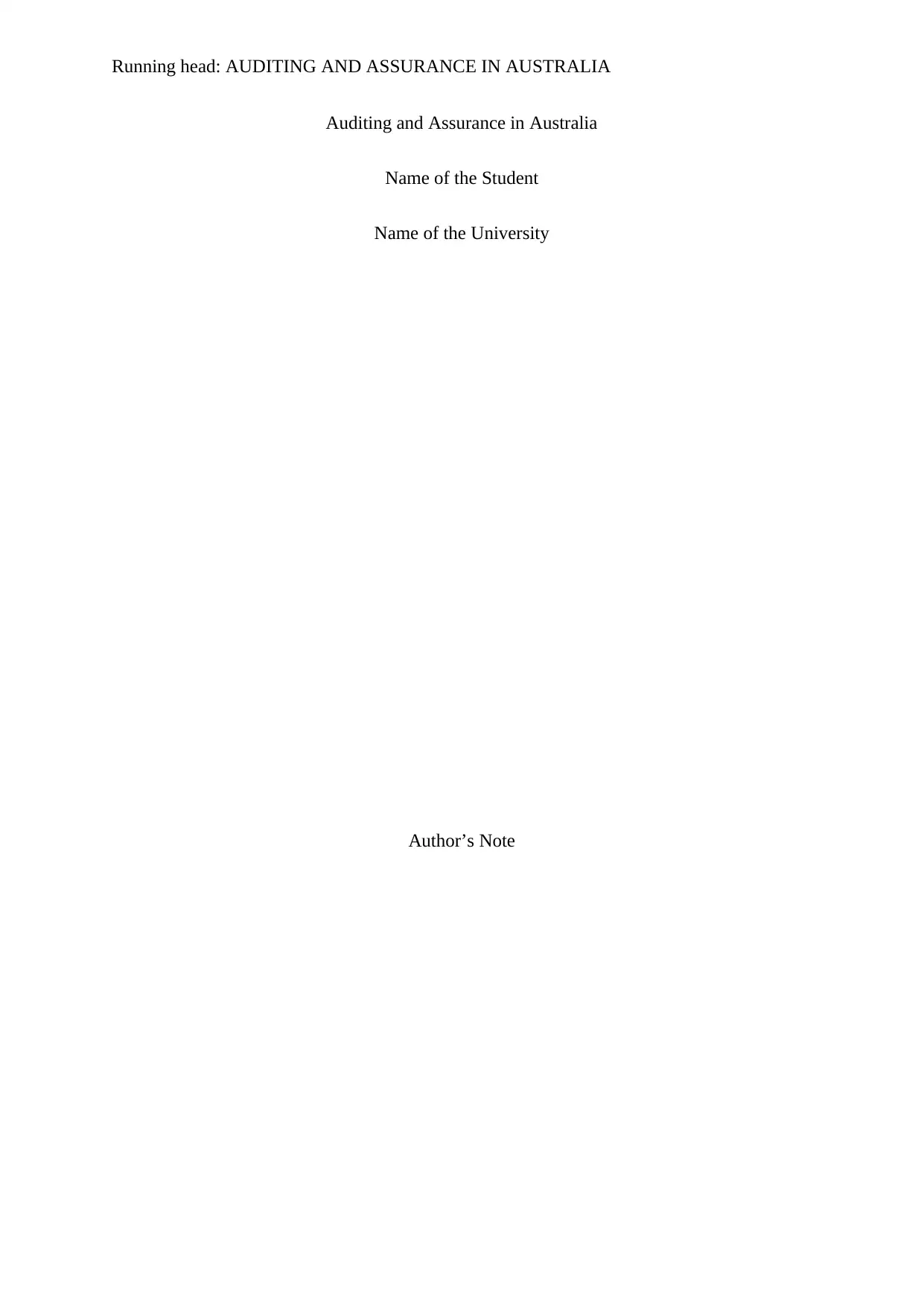
Running head: AUDITING AND ASSURANCE IN AUSTRALIA
Auditing and Assurance in Australia
Name of the Student
Name of the University
Author’s Note
Auditing and Assurance in Australia
Name of the Student
Name of the University
Author’s Note
Secure Best Marks with AI Grader
Need help grading? Try our AI Grader for instant feedback on your assignments.
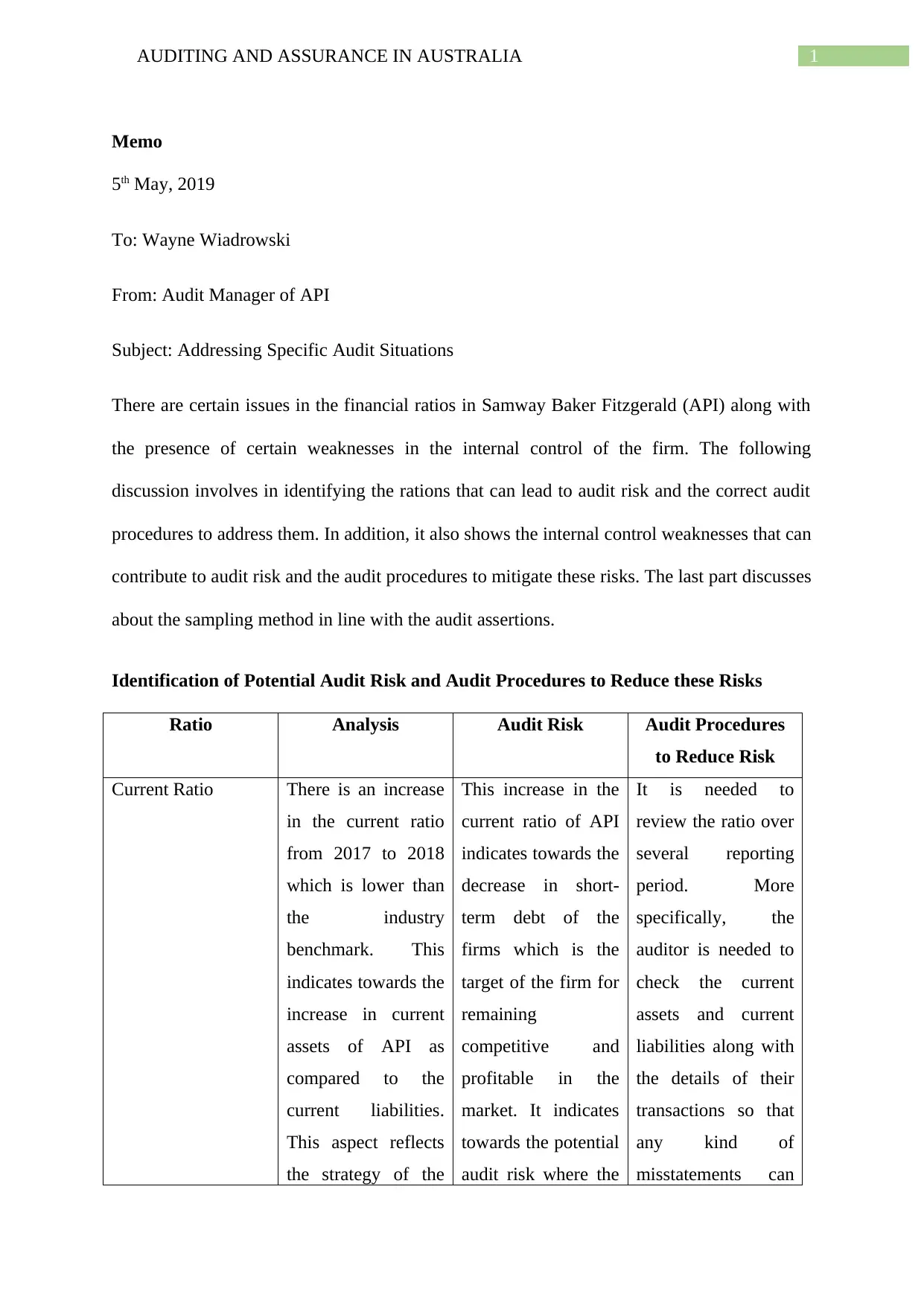
1AUDITING AND ASSURANCE IN AUSTRALIA
Memo
5th May, 2019
To: Wayne Wiadrowski
From: Audit Manager of API
Subject: Addressing Specific Audit Situations
There are certain issues in the financial ratios in Samway Baker Fitzgerald (API) along with
the presence of certain weaknesses in the internal control of the firm. The following
discussion involves in identifying the rations that can lead to audit risk and the correct audit
procedures to address them. In addition, it also shows the internal control weaknesses that can
contribute to audit risk and the audit procedures to mitigate these risks. The last part discusses
about the sampling method in line with the audit assertions.
Identification of Potential Audit Risk and Audit Procedures to Reduce these Risks
Ratio Analysis Audit Risk Audit Procedures
to Reduce Risk
Current Ratio There is an increase
in the current ratio
from 2017 to 2018
which is lower than
the industry
benchmark. This
indicates towards the
increase in current
assets of API as
compared to the
current liabilities.
This aspect reflects
the strategy of the
This increase in the
current ratio of API
indicates towards the
decrease in short-
term debt of the
firms which is the
target of the firm for
remaining
competitive and
profitable in the
market. It indicates
towards the potential
audit risk where the
It is needed to
review the ratio over
several reporting
period. More
specifically, the
auditor is needed to
check the current
assets and current
liabilities along with
the details of their
transactions so that
any kind of
misstatements can
Memo
5th May, 2019
To: Wayne Wiadrowski
From: Audit Manager of API
Subject: Addressing Specific Audit Situations
There are certain issues in the financial ratios in Samway Baker Fitzgerald (API) along with
the presence of certain weaknesses in the internal control of the firm. The following
discussion involves in identifying the rations that can lead to audit risk and the correct audit
procedures to address them. In addition, it also shows the internal control weaknesses that can
contribute to audit risk and the audit procedures to mitigate these risks. The last part discusses
about the sampling method in line with the audit assertions.
Identification of Potential Audit Risk and Audit Procedures to Reduce these Risks
Ratio Analysis Audit Risk Audit Procedures
to Reduce Risk
Current Ratio There is an increase
in the current ratio
from 2017 to 2018
which is lower than
the industry
benchmark. This
indicates towards the
increase in current
assets of API as
compared to the
current liabilities.
This aspect reflects
the strategy of the
This increase in the
current ratio of API
indicates towards the
decrease in short-
term debt of the
firms which is the
target of the firm for
remaining
competitive and
profitable in the
market. It indicates
towards the potential
audit risk where the
It is needed to
review the ratio over
several reporting
period. More
specifically, the
auditor is needed to
check the current
assets and current
liabilities along with
the details of their
transactions so that
any kind of
misstatements can
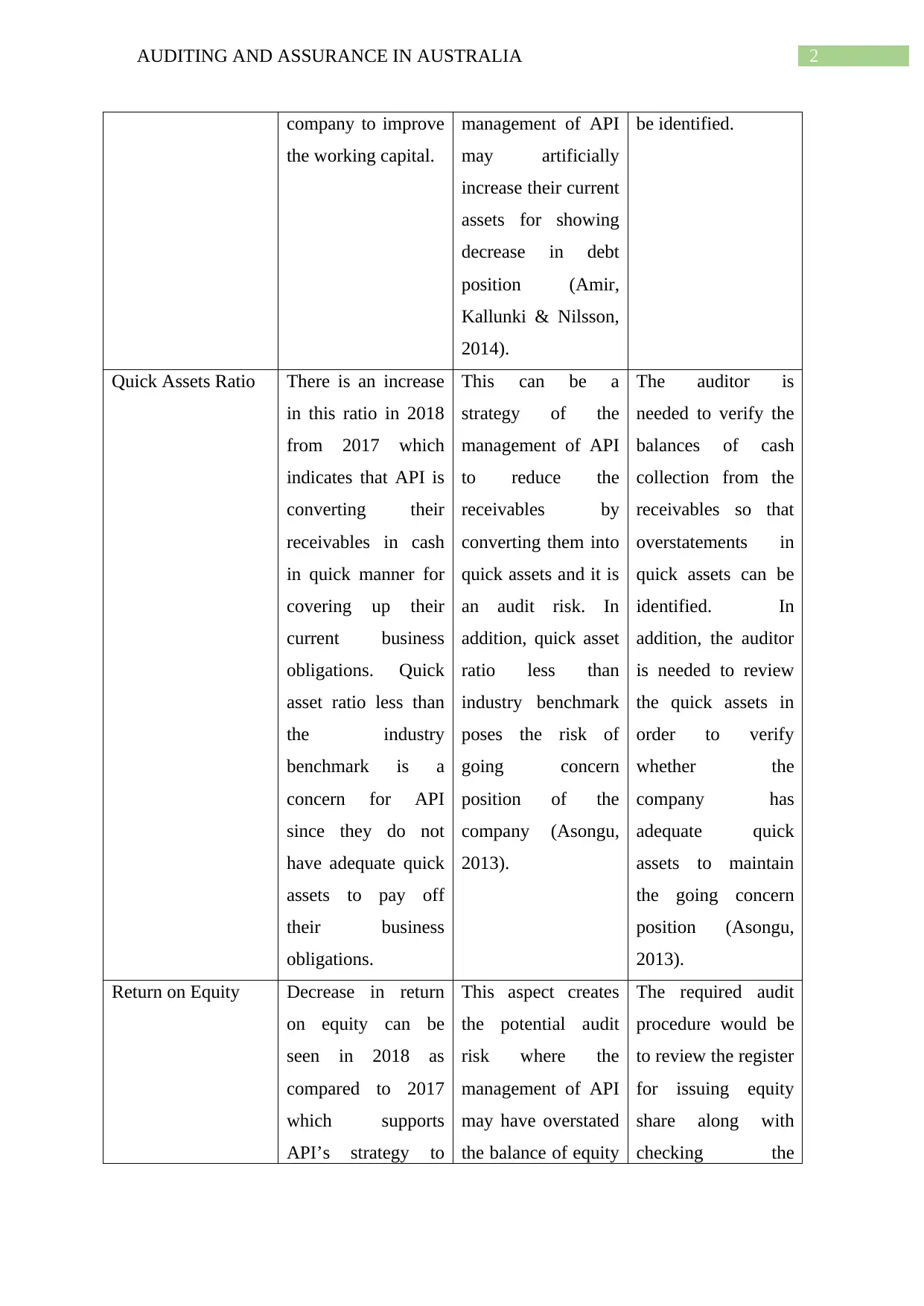
2AUDITING AND ASSURANCE IN AUSTRALIA
company to improve
the working capital.
management of API
may artificially
increase their current
assets for showing
decrease in debt
position (Amir,
Kallunki & Nilsson,
2014).
be identified.
Quick Assets Ratio There is an increase
in this ratio in 2018
from 2017 which
indicates that API is
converting their
receivables in cash
in quick manner for
covering up their
current business
obligations. Quick
asset ratio less than
the industry
benchmark is a
concern for API
since they do not
have adequate quick
assets to pay off
their business
obligations.
This can be a
strategy of the
management of API
to reduce the
receivables by
converting them into
quick assets and it is
an audit risk. In
addition, quick asset
ratio less than
industry benchmark
poses the risk of
going concern
position of the
company (Asongu,
2013).
The auditor is
needed to verify the
balances of cash
collection from the
receivables so that
overstatements in
quick assets can be
identified. In
addition, the auditor
is needed to review
the quick assets in
order to verify
whether the
company has
adequate quick
assets to maintain
the going concern
position (Asongu,
2013).
Return on Equity Decrease in return
on equity can be
seen in 2018 as
compared to 2017
which supports
API’s strategy to
This aspect creates
the potential audit
risk where the
management of API
may have overstated
the balance of equity
The required audit
procedure would be
to review the register
for issuing equity
share along with
checking the
company to improve
the working capital.
management of API
may artificially
increase their current
assets for showing
decrease in debt
position (Amir,
Kallunki & Nilsson,
2014).
be identified.
Quick Assets Ratio There is an increase
in this ratio in 2018
from 2017 which
indicates that API is
converting their
receivables in cash
in quick manner for
covering up their
current business
obligations. Quick
asset ratio less than
the industry
benchmark is a
concern for API
since they do not
have adequate quick
assets to pay off
their business
obligations.
This can be a
strategy of the
management of API
to reduce the
receivables by
converting them into
quick assets and it is
an audit risk. In
addition, quick asset
ratio less than
industry benchmark
poses the risk of
going concern
position of the
company (Asongu,
2013).
The auditor is
needed to verify the
balances of cash
collection from the
receivables so that
overstatements in
quick assets can be
identified. In
addition, the auditor
is needed to review
the quick assets in
order to verify
whether the
company has
adequate quick
assets to maintain
the going concern
position (Asongu,
2013).
Return on Equity Decrease in return
on equity can be
seen in 2018 as
compared to 2017
which supports
API’s strategy to
This aspect creates
the potential audit
risk where the
management of API
may have overstated
the balance of equity
The required audit
procedure would be
to review the register
for issuing equity
share along with
checking the
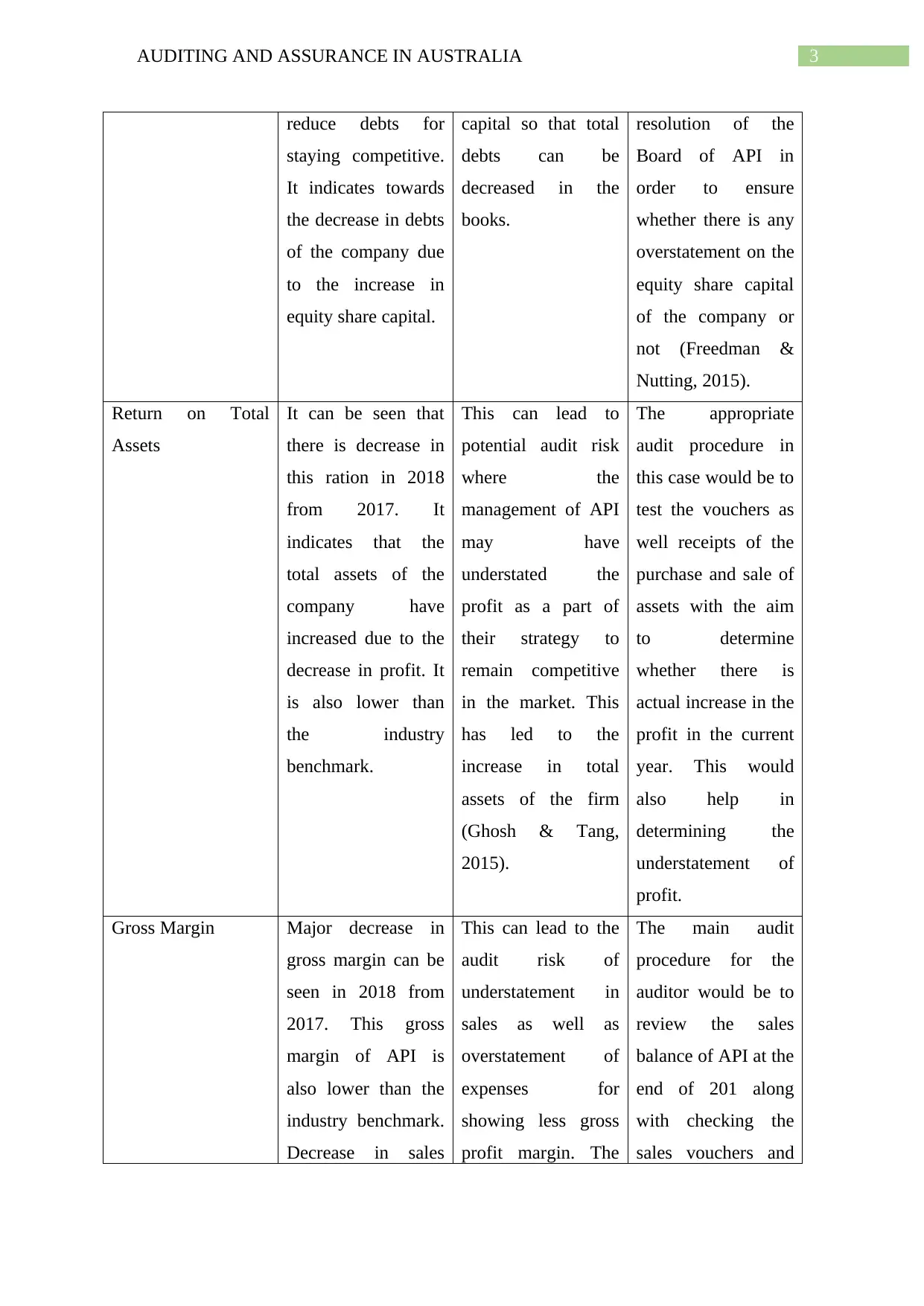
3AUDITING AND ASSURANCE IN AUSTRALIA
reduce debts for
staying competitive.
It indicates towards
the decrease in debts
of the company due
to the increase in
equity share capital.
capital so that total
debts can be
decreased in the
books.
resolution of the
Board of API in
order to ensure
whether there is any
overstatement on the
equity share capital
of the company or
not (Freedman &
Nutting, 2015).
Return on Total
Assets
It can be seen that
there is decrease in
this ration in 2018
from 2017. It
indicates that the
total assets of the
company have
increased due to the
decrease in profit. It
is also lower than
the industry
benchmark.
This can lead to
potential audit risk
where the
management of API
may have
understated the
profit as a part of
their strategy to
remain competitive
in the market. This
has led to the
increase in total
assets of the firm
(Ghosh & Tang,
2015).
The appropriate
audit procedure in
this case would be to
test the vouchers as
well receipts of the
purchase and sale of
assets with the aim
to determine
whether there is
actual increase in the
profit in the current
year. This would
also help in
determining the
understatement of
profit.
Gross Margin Major decrease in
gross margin can be
seen in 2018 from
2017. This gross
margin of API is
also lower than the
industry benchmark.
Decrease in sales
This can lead to the
audit risk of
understatement in
sales as well as
overstatement of
expenses for
showing less gross
profit margin. The
The main audit
procedure for the
auditor would be to
review the sales
balance of API at the
end of 201 along
with checking the
sales vouchers and
reduce debts for
staying competitive.
It indicates towards
the decrease in debts
of the company due
to the increase in
equity share capital.
capital so that total
debts can be
decreased in the
books.
resolution of the
Board of API in
order to ensure
whether there is any
overstatement on the
equity share capital
of the company or
not (Freedman &
Nutting, 2015).
Return on Total
Assets
It can be seen that
there is decrease in
this ration in 2018
from 2017. It
indicates that the
total assets of the
company have
increased due to the
decrease in profit. It
is also lower than
the industry
benchmark.
This can lead to
potential audit risk
where the
management of API
may have
understated the
profit as a part of
their strategy to
remain competitive
in the market. This
has led to the
increase in total
assets of the firm
(Ghosh & Tang,
2015).
The appropriate
audit procedure in
this case would be to
test the vouchers as
well receipts of the
purchase and sale of
assets with the aim
to determine
whether there is
actual increase in the
profit in the current
year. This would
also help in
determining the
understatement of
profit.
Gross Margin Major decrease in
gross margin can be
seen in 2018 from
2017. This gross
margin of API is
also lower than the
industry benchmark.
Decrease in sales
This can lead to the
audit risk of
understatement in
sales as well as
overstatement of
expenses for
showing less gross
profit margin. The
The main audit
procedure for the
auditor would be to
review the sales
balance of API at the
end of 201 along
with checking the
sales vouchers and
Secure Best Marks with AI Grader
Need help grading? Try our AI Grader for instant feedback on your assignments.
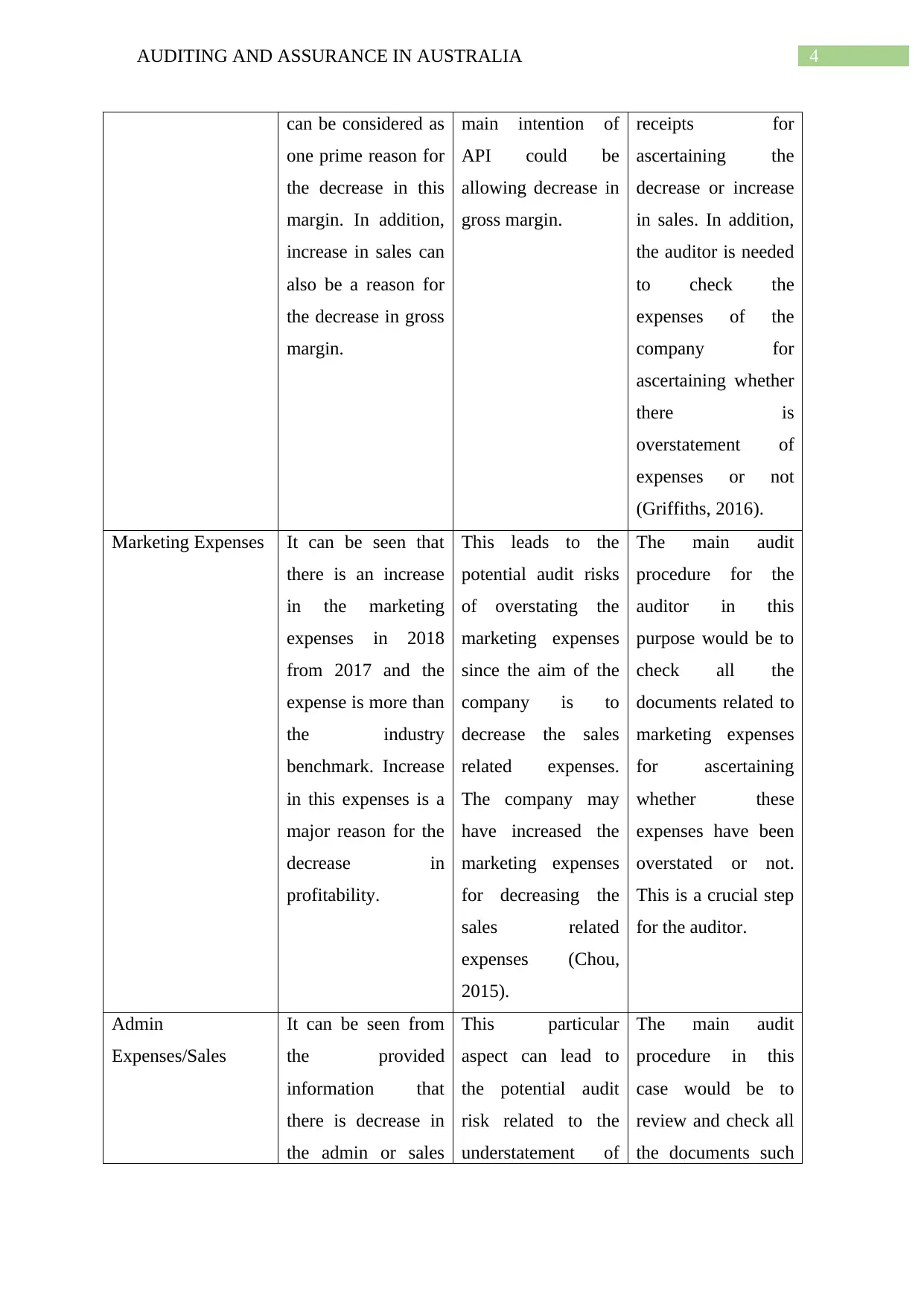
4AUDITING AND ASSURANCE IN AUSTRALIA
can be considered as
one prime reason for
the decrease in this
margin. In addition,
increase in sales can
also be a reason for
the decrease in gross
margin.
main intention of
API could be
allowing decrease in
gross margin.
receipts for
ascertaining the
decrease or increase
in sales. In addition,
the auditor is needed
to check the
expenses of the
company for
ascertaining whether
there is
overstatement of
expenses or not
(Griffiths, 2016).
Marketing Expenses It can be seen that
there is an increase
in the marketing
expenses in 2018
from 2017 and the
expense is more than
the industry
benchmark. Increase
in this expenses is a
major reason for the
decrease in
profitability.
This leads to the
potential audit risks
of overstating the
marketing expenses
since the aim of the
company is to
decrease the sales
related expenses.
The company may
have increased the
marketing expenses
for decreasing the
sales related
expenses (Chou,
2015).
The main audit
procedure for the
auditor in this
purpose would be to
check all the
documents related to
marketing expenses
for ascertaining
whether these
expenses have been
overstated or not.
This is a crucial step
for the auditor.
Admin
Expenses/Sales
It can be seen from
the provided
information that
there is decrease in
the admin or sales
This particular
aspect can lead to
the potential audit
risk related to the
understatement of
The main audit
procedure in this
case would be to
review and check all
the documents such
can be considered as
one prime reason for
the decrease in this
margin. In addition,
increase in sales can
also be a reason for
the decrease in gross
margin.
main intention of
API could be
allowing decrease in
gross margin.
receipts for
ascertaining the
decrease or increase
in sales. In addition,
the auditor is needed
to check the
expenses of the
company for
ascertaining whether
there is
overstatement of
expenses or not
(Griffiths, 2016).
Marketing Expenses It can be seen that
there is an increase
in the marketing
expenses in 2018
from 2017 and the
expense is more than
the industry
benchmark. Increase
in this expenses is a
major reason for the
decrease in
profitability.
This leads to the
potential audit risks
of overstating the
marketing expenses
since the aim of the
company is to
decrease the sales
related expenses.
The company may
have increased the
marketing expenses
for decreasing the
sales related
expenses (Chou,
2015).
The main audit
procedure for the
auditor in this
purpose would be to
check all the
documents related to
marketing expenses
for ascertaining
whether these
expenses have been
overstated or not.
This is a crucial step
for the auditor.
Admin
Expenses/Sales
It can be seen from
the provided
information that
there is decrease in
the admin or sales
This particular
aspect can lead to
the potential audit
risk related to the
understatement of
The main audit
procedure in this
case would be to
review and check all
the documents such
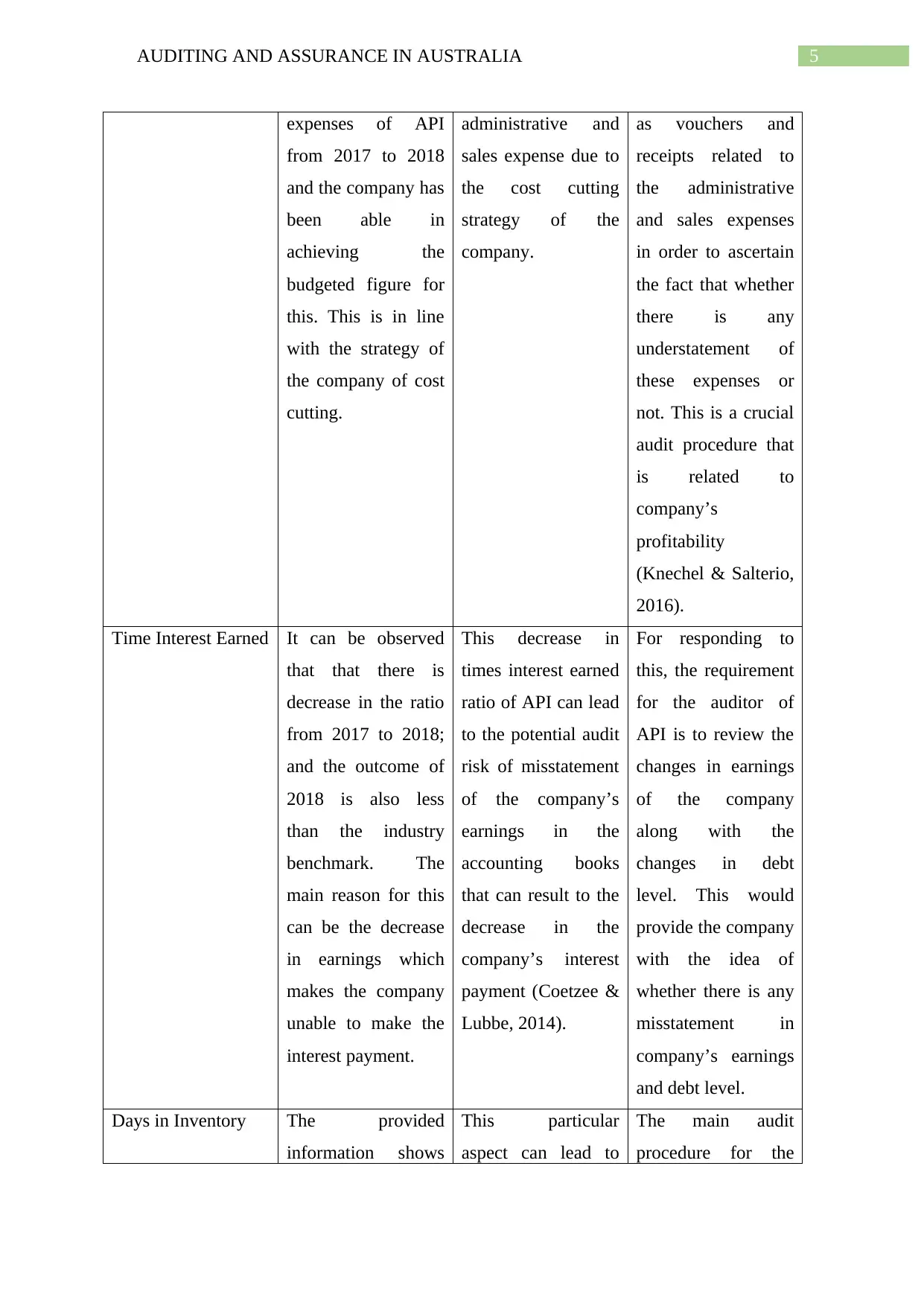
5AUDITING AND ASSURANCE IN AUSTRALIA
expenses of API
from 2017 to 2018
and the company has
been able in
achieving the
budgeted figure for
this. This is in line
with the strategy of
the company of cost
cutting.
administrative and
sales expense due to
the cost cutting
strategy of the
company.
as vouchers and
receipts related to
the administrative
and sales expenses
in order to ascertain
the fact that whether
there is any
understatement of
these expenses or
not. This is a crucial
audit procedure that
is related to
company’s
profitability
(Knechel & Salterio,
2016).
Time Interest Earned It can be observed
that that there is
decrease in the ratio
from 2017 to 2018;
and the outcome of
2018 is also less
than the industry
benchmark. The
main reason for this
can be the decrease
in earnings which
makes the company
unable to make the
interest payment.
This decrease in
times interest earned
ratio of API can lead
to the potential audit
risk of misstatement
of the company’s
earnings in the
accounting books
that can result to the
decrease in the
company’s interest
payment (Coetzee &
Lubbe, 2014).
For responding to
this, the requirement
for the auditor of
API is to review the
changes in earnings
of the company
along with the
changes in debt
level. This would
provide the company
with the idea of
whether there is any
misstatement in
company’s earnings
and debt level.
Days in Inventory The provided
information shows
This particular
aspect can lead to
The main audit
procedure for the
expenses of API
from 2017 to 2018
and the company has
been able in
achieving the
budgeted figure for
this. This is in line
with the strategy of
the company of cost
cutting.
administrative and
sales expense due to
the cost cutting
strategy of the
company.
as vouchers and
receipts related to
the administrative
and sales expenses
in order to ascertain
the fact that whether
there is any
understatement of
these expenses or
not. This is a crucial
audit procedure that
is related to
company’s
profitability
(Knechel & Salterio,
2016).
Time Interest Earned It can be observed
that that there is
decrease in the ratio
from 2017 to 2018;
and the outcome of
2018 is also less
than the industry
benchmark. The
main reason for this
can be the decrease
in earnings which
makes the company
unable to make the
interest payment.
This decrease in
times interest earned
ratio of API can lead
to the potential audit
risk of misstatement
of the company’s
earnings in the
accounting books
that can result to the
decrease in the
company’s interest
payment (Coetzee &
Lubbe, 2014).
For responding to
this, the requirement
for the auditor of
API is to review the
changes in earnings
of the company
along with the
changes in debt
level. This would
provide the company
with the idea of
whether there is any
misstatement in
company’s earnings
and debt level.
Days in Inventory The provided
information shows
This particular
aspect can lead to
The main audit
procedure for the

6AUDITING AND ASSURANCE IN AUSTRALIA
that that there is
increase in inventory
turnover of API in
the year 2018 as
compared to 2017;
and this value is
greater than the
industry benchmark.
It implies that API
has cleared their
inventory in faster
manner. De-growth
in sales can be
considered as a
major reason for the
increase in days in
inventory.
the potential audit
risk where the
management of API
may have overstated
the closing inventory
since it would help
the management in
reducing the level of
inventory.
auditor would be
reviewing and
observing the
inventory count in
the company. In this
process, the auditor
would be able in
identifying the
presence of
overstatement in
closing inventory, if
any (Johnstone,
Gramling &
Rittenberg, 2013).
Days in Accounts
Receivable
It can be seen that
there is an increase
in days in accounts
receivable of API in
2018 as compared to
2017 and it is more
than the industry
benchmark. It
implies that the
company has taken
more time to collect
the accounts
receivable in 2018.
This increase in days
in accounts
receivable can create
the potential audit
risk of the
misstatement of
accounts receivable
and the main
incentive of the
management of API
behind this is to
improve working
capital.
For this audit risk,
the appropriate audit
procedure would be
reviewing the entire
set of invoices that
APIhas outstanding
for the period. This
would lead to the
identification of any
kind of
misstatements in the
balance of accounts
receivable (Griffiths,
2016).
Debt to Equity Ratio It can be seen from
the provided
This particular
situation indicates
The main audit
procedure in this
that that there is
increase in inventory
turnover of API in
the year 2018 as
compared to 2017;
and this value is
greater than the
industry benchmark.
It implies that API
has cleared their
inventory in faster
manner. De-growth
in sales can be
considered as a
major reason for the
increase in days in
inventory.
the potential audit
risk where the
management of API
may have overstated
the closing inventory
since it would help
the management in
reducing the level of
inventory.
auditor would be
reviewing and
observing the
inventory count in
the company. In this
process, the auditor
would be able in
identifying the
presence of
overstatement in
closing inventory, if
any (Johnstone,
Gramling &
Rittenberg, 2013).
Days in Accounts
Receivable
It can be seen that
there is an increase
in days in accounts
receivable of API in
2018 as compared to
2017 and it is more
than the industry
benchmark. It
implies that the
company has taken
more time to collect
the accounts
receivable in 2018.
This increase in days
in accounts
receivable can create
the potential audit
risk of the
misstatement of
accounts receivable
and the main
incentive of the
management of API
behind this is to
improve working
capital.
For this audit risk,
the appropriate audit
procedure would be
reviewing the entire
set of invoices that
APIhas outstanding
for the period. This
would lead to the
identification of any
kind of
misstatements in the
balance of accounts
receivable (Griffiths,
2016).
Debt to Equity Ratio It can be seen from
the provided
This particular
situation indicates
The main audit
procedure in this
Paraphrase This Document
Need a fresh take? Get an instant paraphrase of this document with our AI Paraphraser
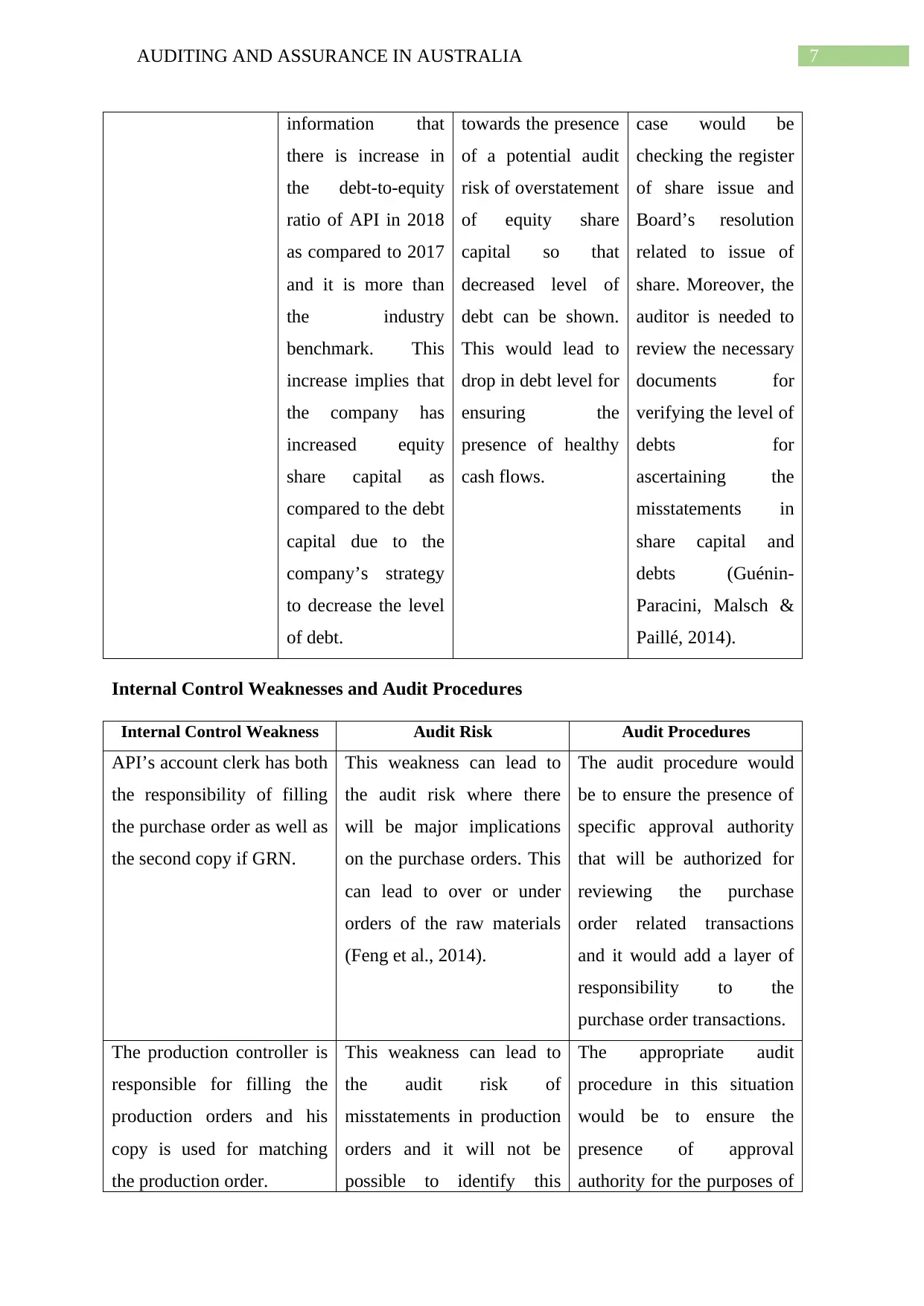
7AUDITING AND ASSURANCE IN AUSTRALIA
information that
there is increase in
the debt-to-equity
ratio of API in 2018
as compared to 2017
and it is more than
the industry
benchmark. This
increase implies that
the company has
increased equity
share capital as
compared to the debt
capital due to the
company’s strategy
to decrease the level
of debt.
towards the presence
of a potential audit
risk of overstatement
of equity share
capital so that
decreased level of
debt can be shown.
This would lead to
drop in debt level for
ensuring the
presence of healthy
cash flows.
case would be
checking the register
of share issue and
Board’s resolution
related to issue of
share. Moreover, the
auditor is needed to
review the necessary
documents for
verifying the level of
debts for
ascertaining the
misstatements in
share capital and
debts (Guénin-
Paracini, Malsch &
Paillé, 2014).
Internal Control Weaknesses and Audit Procedures
Internal Control Weakness Audit Risk Audit Procedures
API’s account clerk has both
the responsibility of filling
the purchase order as well as
the second copy if GRN.
This weakness can lead to
the audit risk where there
will be major implications
on the purchase orders. This
can lead to over or under
orders of the raw materials
(Feng et al., 2014).
The audit procedure would
be to ensure the presence of
specific approval authority
that will be authorized for
reviewing the purchase
order related transactions
and it would add a layer of
responsibility to the
purchase order transactions.
The production controller is
responsible for filling the
production orders and his
copy is used for matching
the production order.
This weakness can lead to
the audit risk of
misstatements in production
orders and it will not be
possible to identify this
The appropriate audit
procedure in this situation
would be to ensure the
presence of approval
authority for the purposes of
information that
there is increase in
the debt-to-equity
ratio of API in 2018
as compared to 2017
and it is more than
the industry
benchmark. This
increase implies that
the company has
increased equity
share capital as
compared to the debt
capital due to the
company’s strategy
to decrease the level
of debt.
towards the presence
of a potential audit
risk of overstatement
of equity share
capital so that
decreased level of
debt can be shown.
This would lead to
drop in debt level for
ensuring the
presence of healthy
cash flows.
case would be
checking the register
of share issue and
Board’s resolution
related to issue of
share. Moreover, the
auditor is needed to
review the necessary
documents for
verifying the level of
debts for
ascertaining the
misstatements in
share capital and
debts (Guénin-
Paracini, Malsch &
Paillé, 2014).
Internal Control Weaknesses and Audit Procedures
Internal Control Weakness Audit Risk Audit Procedures
API’s account clerk has both
the responsibility of filling
the purchase order as well as
the second copy if GRN.
This weakness can lead to
the audit risk where there
will be major implications
on the purchase orders. This
can lead to over or under
orders of the raw materials
(Feng et al., 2014).
The audit procedure would
be to ensure the presence of
specific approval authority
that will be authorized for
reviewing the purchase
order related transactions
and it would add a layer of
responsibility to the
purchase order transactions.
The production controller is
responsible for filling the
production orders and his
copy is used for matching
the production order.
This weakness can lead to
the audit risk of
misstatements in production
orders and it will not be
possible to identify this
The appropriate audit
procedure in this situation
would be to ensure the
presence of approval
authority for the purposes of
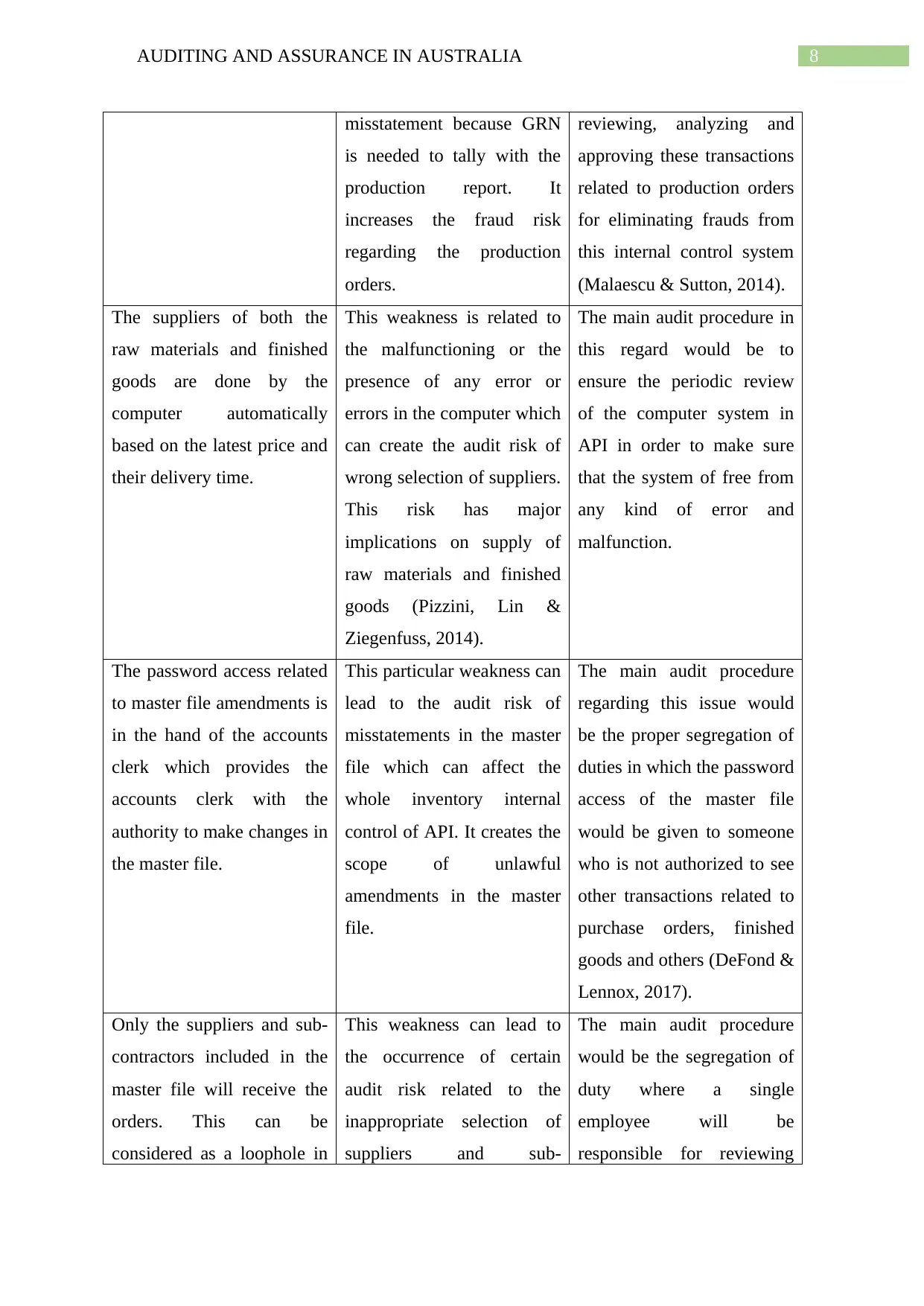
8AUDITING AND ASSURANCE IN AUSTRALIA
misstatement because GRN
is needed to tally with the
production report. It
increases the fraud risk
regarding the production
orders.
reviewing, analyzing and
approving these transactions
related to production orders
for eliminating frauds from
this internal control system
(Malaescu & Sutton, 2014).
The suppliers of both the
raw materials and finished
goods are done by the
computer automatically
based on the latest price and
their delivery time.
This weakness is related to
the malfunctioning or the
presence of any error or
errors in the computer which
can create the audit risk of
wrong selection of suppliers.
This risk has major
implications on supply of
raw materials and finished
goods (Pizzini, Lin &
Ziegenfuss, 2014).
The main audit procedure in
this regard would be to
ensure the periodic review
of the computer system in
API in order to make sure
that the system of free from
any kind of error and
malfunction.
The password access related
to master file amendments is
in the hand of the accounts
clerk which provides the
accounts clerk with the
authority to make changes in
the master file.
This particular weakness can
lead to the audit risk of
misstatements in the master
file which can affect the
whole inventory internal
control of API. It creates the
scope of unlawful
amendments in the master
file.
The main audit procedure
regarding this issue would
be the proper segregation of
duties in which the password
access of the master file
would be given to someone
who is not authorized to see
other transactions related to
purchase orders, finished
goods and others (DeFond &
Lennox, 2017).
Only the suppliers and sub-
contractors included in the
master file will receive the
orders. This can be
considered as a loophole in
This weakness can lead to
the occurrence of certain
audit risk related to the
inappropriate selection of
suppliers and sub-
The main audit procedure
would be the segregation of
duty where a single
employee will be
responsible for reviewing
misstatement because GRN
is needed to tally with the
production report. It
increases the fraud risk
regarding the production
orders.
reviewing, analyzing and
approving these transactions
related to production orders
for eliminating frauds from
this internal control system
(Malaescu & Sutton, 2014).
The suppliers of both the
raw materials and finished
goods are done by the
computer automatically
based on the latest price and
their delivery time.
This weakness is related to
the malfunctioning or the
presence of any error or
errors in the computer which
can create the audit risk of
wrong selection of suppliers.
This risk has major
implications on supply of
raw materials and finished
goods (Pizzini, Lin &
Ziegenfuss, 2014).
The main audit procedure in
this regard would be to
ensure the periodic review
of the computer system in
API in order to make sure
that the system of free from
any kind of error and
malfunction.
The password access related
to master file amendments is
in the hand of the accounts
clerk which provides the
accounts clerk with the
authority to make changes in
the master file.
This particular weakness can
lead to the audit risk of
misstatements in the master
file which can affect the
whole inventory internal
control of API. It creates the
scope of unlawful
amendments in the master
file.
The main audit procedure
regarding this issue would
be the proper segregation of
duties in which the password
access of the master file
would be given to someone
who is not authorized to see
other transactions related to
purchase orders, finished
goods and others (DeFond &
Lennox, 2017).
Only the suppliers and sub-
contractors included in the
master file will receive the
orders. This can be
considered as a loophole in
This weakness can lead to
the occurrence of certain
audit risk related to the
inappropriate selection of
suppliers and sub-
The main audit procedure
would be the segregation of
duty where a single
employee will be
responsible for reviewing
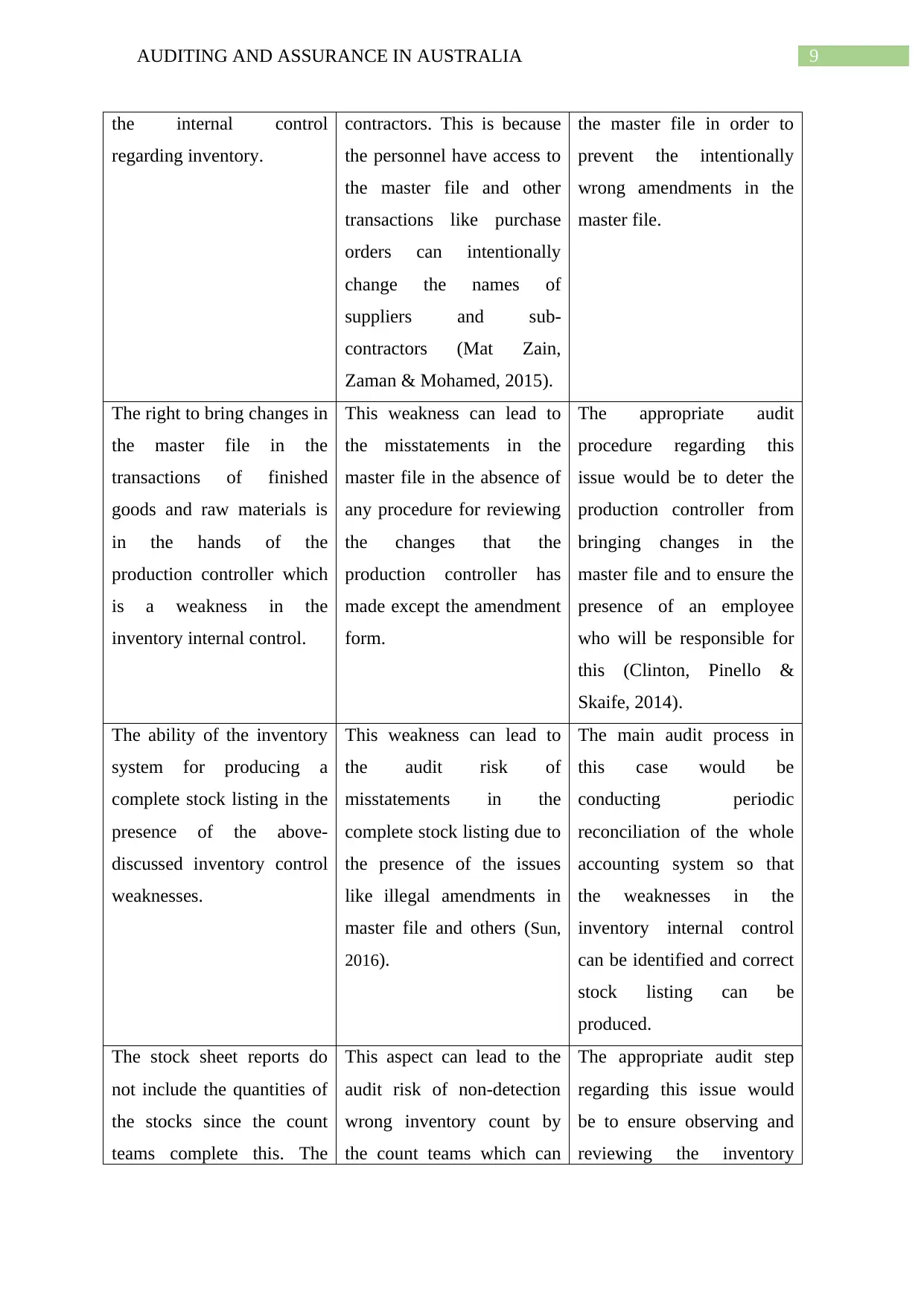
9AUDITING AND ASSURANCE IN AUSTRALIA
the internal control
regarding inventory.
contractors. This is because
the personnel have access to
the master file and other
transactions like purchase
orders can intentionally
change the names of
suppliers and sub-
contractors (Mat Zain,
Zaman & Mohamed, 2015).
the master file in order to
prevent the intentionally
wrong amendments in the
master file.
The right to bring changes in
the master file in the
transactions of finished
goods and raw materials is
in the hands of the
production controller which
is a weakness in the
inventory internal control.
This weakness can lead to
the misstatements in the
master file in the absence of
any procedure for reviewing
the changes that the
production controller has
made except the amendment
form.
The appropriate audit
procedure regarding this
issue would be to deter the
production controller from
bringing changes in the
master file and to ensure the
presence of an employee
who will be responsible for
this (Clinton, Pinello &
Skaife, 2014).
The ability of the inventory
system for producing a
complete stock listing in the
presence of the above-
discussed inventory control
weaknesses.
This weakness can lead to
the audit risk of
misstatements in the
complete stock listing due to
the presence of the issues
like illegal amendments in
master file and others (Sun,
2016).
The main audit process in
this case would be
conducting periodic
reconciliation of the whole
accounting system so that
the weaknesses in the
inventory internal control
can be identified and correct
stock listing can be
produced.
The stock sheet reports do
not include the quantities of
the stocks since the count
teams complete this. The
This aspect can lead to the
audit risk of non-detection
wrong inventory count by
the count teams which can
The appropriate audit step
regarding this issue would
be to ensure observing and
reviewing the inventory
the internal control
regarding inventory.
contractors. This is because
the personnel have access to
the master file and other
transactions like purchase
orders can intentionally
change the names of
suppliers and sub-
contractors (Mat Zain,
Zaman & Mohamed, 2015).
the master file in order to
prevent the intentionally
wrong amendments in the
master file.
The right to bring changes in
the master file in the
transactions of finished
goods and raw materials is
in the hands of the
production controller which
is a weakness in the
inventory internal control.
This weakness can lead to
the misstatements in the
master file in the absence of
any procedure for reviewing
the changes that the
production controller has
made except the amendment
form.
The appropriate audit
procedure regarding this
issue would be to deter the
production controller from
bringing changes in the
master file and to ensure the
presence of an employee
who will be responsible for
this (Clinton, Pinello &
Skaife, 2014).
The ability of the inventory
system for producing a
complete stock listing in the
presence of the above-
discussed inventory control
weaknesses.
This weakness can lead to
the audit risk of
misstatements in the
complete stock listing due to
the presence of the issues
like illegal amendments in
master file and others (Sun,
2016).
The main audit process in
this case would be
conducting periodic
reconciliation of the whole
accounting system so that
the weaknesses in the
inventory internal control
can be identified and correct
stock listing can be
produced.
The stock sheet reports do
not include the quantities of
the stocks since the count
teams complete this. The
This aspect can lead to the
audit risk of non-detection
wrong inventory count by
the count teams which can
The appropriate audit step
regarding this issue would
be to ensure observing and
reviewing the inventory
Secure Best Marks with AI Grader
Need help grading? Try our AI Grader for instant feedback on your assignments.
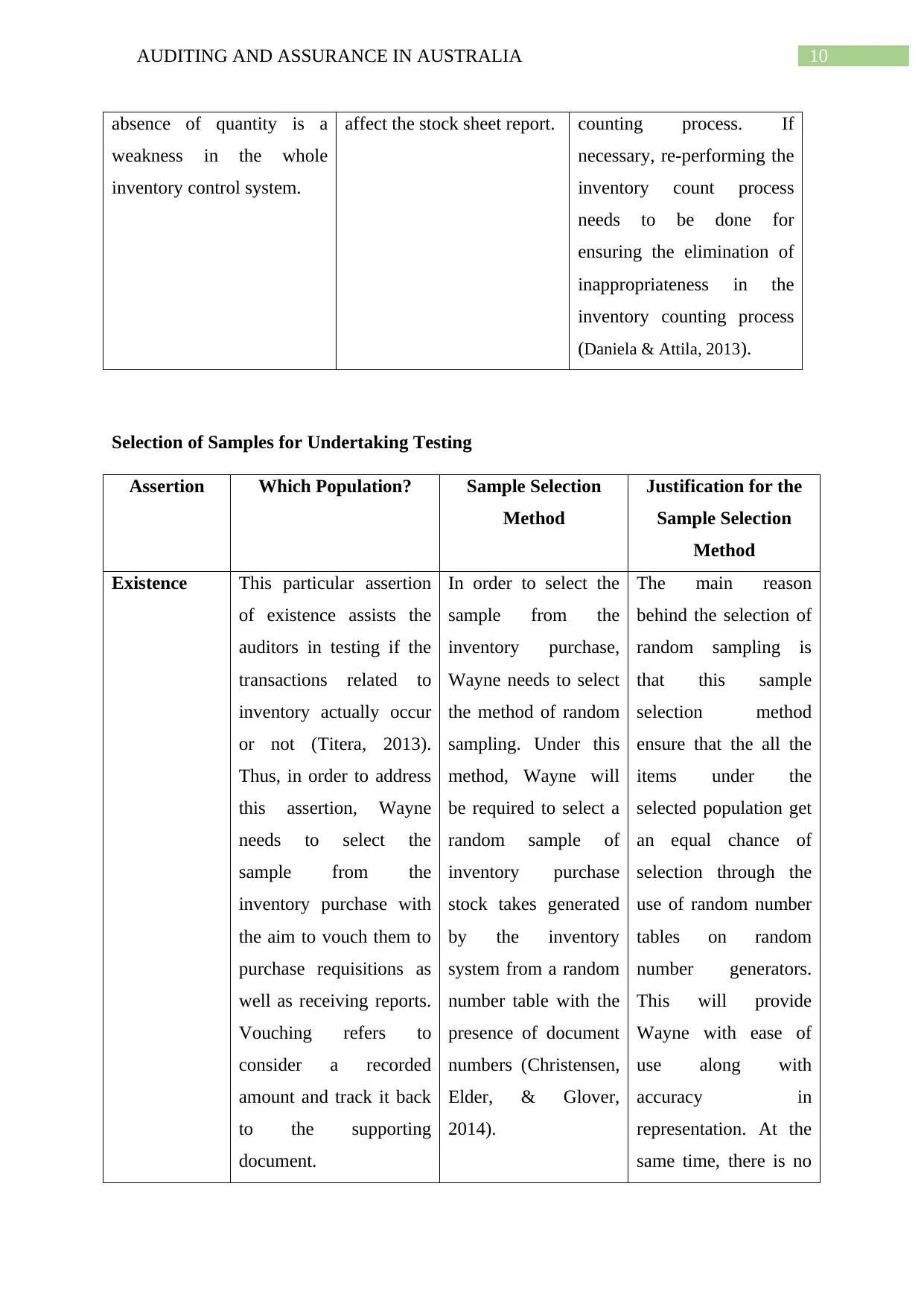
10AUDITING AND ASSURANCE IN AUSTRALIA
absence of quantity is a
weakness in the whole
inventory control system.
affect the stock sheet report. counting process. If
necessary, re-performing the
inventory count process
needs to be done for
ensuring the elimination of
inappropriateness in the
inventory counting process
(Daniela & Attila, 2013).
Selection of Samples for Undertaking Testing
Assertion Which Population? Sample Selection
Method
Justification for the
Sample Selection
Method
Existence This particular assertion
of existence assists the
auditors in testing if the
transactions related to
inventory actually occur
or not (Titera, 2013).
Thus, in order to address
this assertion, Wayne
needs to select the
sample from the
inventory purchase with
the aim to vouch them to
purchase requisitions as
well as receiving reports.
Vouching refers to
consider a recorded
amount and track it back
to the supporting
document.
In order to select the
sample from the
inventory purchase,
Wayne needs to select
the method of random
sampling. Under this
method, Wayne will
be required to select a
random sample of
inventory purchase
stock takes generated
by the inventory
system from a random
number table with the
presence of document
numbers (Christensen,
Elder, & Glover,
2014).
The main reason
behind the selection of
random sampling is
that this sample
selection method
ensure that the all the
items under the
selected population get
an equal chance of
selection through the
use of random number
tables on random
number generators.
This will provide
Wayne with ease of
use along with
accuracy in
representation. At the
same time, there is no
absence of quantity is a
weakness in the whole
inventory control system.
affect the stock sheet report. counting process. If
necessary, re-performing the
inventory count process
needs to be done for
ensuring the elimination of
inappropriateness in the
inventory counting process
(Daniela & Attila, 2013).
Selection of Samples for Undertaking Testing
Assertion Which Population? Sample Selection
Method
Justification for the
Sample Selection
Method
Existence This particular assertion
of existence assists the
auditors in testing if the
transactions related to
inventory actually occur
or not (Titera, 2013).
Thus, in order to address
this assertion, Wayne
needs to select the
sample from the
inventory purchase with
the aim to vouch them to
purchase requisitions as
well as receiving reports.
Vouching refers to
consider a recorded
amount and track it back
to the supporting
document.
In order to select the
sample from the
inventory purchase,
Wayne needs to select
the method of random
sampling. Under this
method, Wayne will
be required to select a
random sample of
inventory purchase
stock takes generated
by the inventory
system from a random
number table with the
presence of document
numbers (Christensen,
Elder, & Glover,
2014).
The main reason
behind the selection of
random sampling is
that this sample
selection method
ensure that the all the
items under the
selected population get
an equal chance of
selection through the
use of random number
tables on random
number generators.
This will provide
Wayne with ease of
use along with
accuracy in
representation. At the
same time, there is no
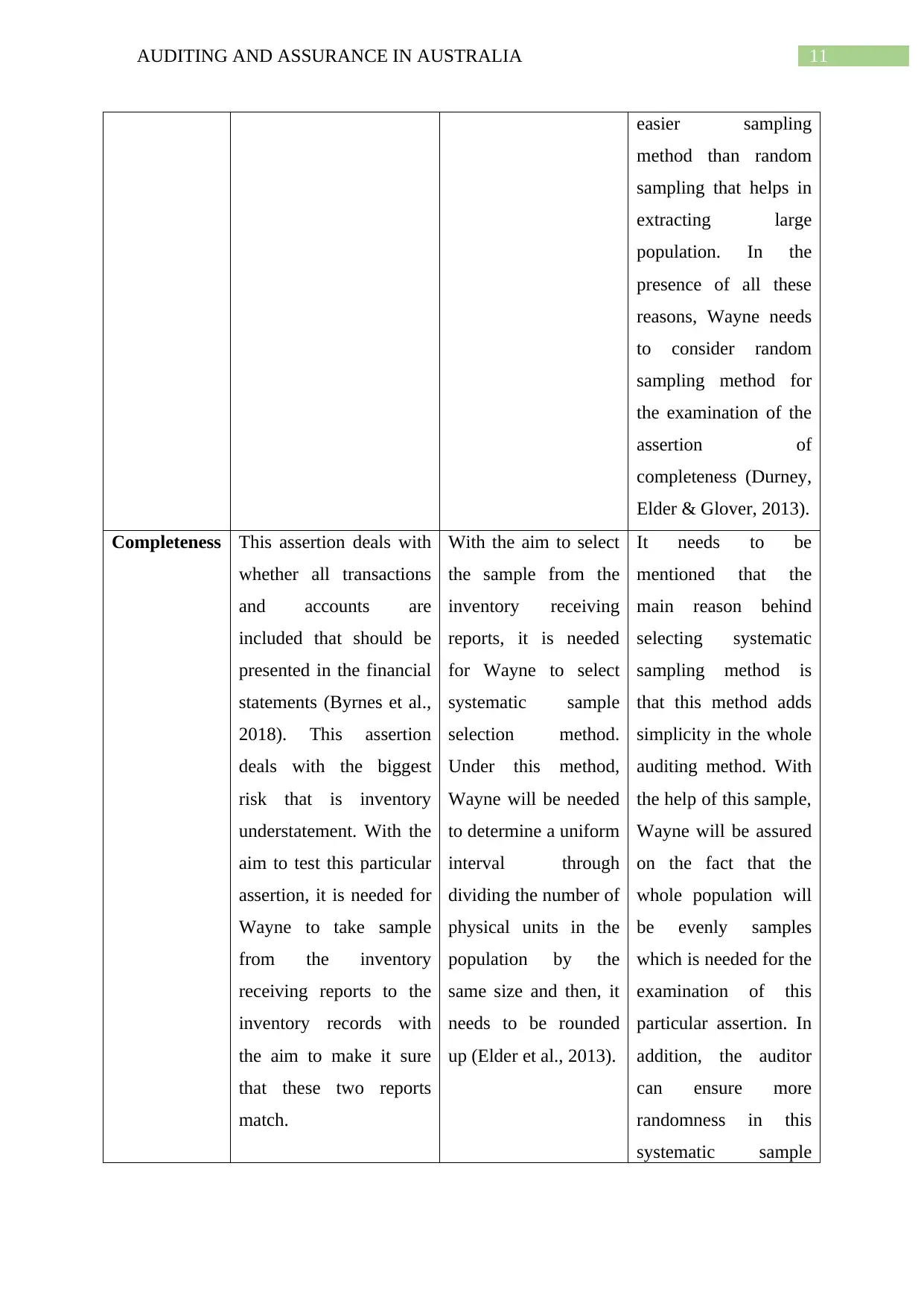
11AUDITING AND ASSURANCE IN AUSTRALIA
easier sampling
method than random
sampling that helps in
extracting large
population. In the
presence of all these
reasons, Wayne needs
to consider random
sampling method for
the examination of the
assertion of
completeness (Durney,
Elder & Glover, 2013).
Completeness This assertion deals with
whether all transactions
and accounts are
included that should be
presented in the financial
statements (Byrnes et al.,
2018). This assertion
deals with the biggest
risk that is inventory
understatement. With the
aim to test this particular
assertion, it is needed for
Wayne to take sample
from the inventory
receiving reports to the
inventory records with
the aim to make it sure
that these two reports
match.
With the aim to select
the sample from the
inventory receiving
reports, it is needed
for Wayne to select
systematic sample
selection method.
Under this method,
Wayne will be needed
to determine a uniform
interval through
dividing the number of
physical units in the
population by the
same size and then, it
needs to be rounded
up (Elder et al., 2013).
It needs to be
mentioned that the
main reason behind
selecting systematic
sampling method is
that this method adds
simplicity in the whole
auditing method. With
the help of this sample,
Wayne will be assured
on the fact that the
whole population will
be evenly samples
which is needed for the
examination of this
particular assertion. In
addition, the auditor
can ensure more
randomness in this
systematic sample
easier sampling
method than random
sampling that helps in
extracting large
population. In the
presence of all these
reasons, Wayne needs
to consider random
sampling method for
the examination of the
assertion of
completeness (Durney,
Elder & Glover, 2013).
Completeness This assertion deals with
whether all transactions
and accounts are
included that should be
presented in the financial
statements (Byrnes et al.,
2018). This assertion
deals with the biggest
risk that is inventory
understatement. With the
aim to test this particular
assertion, it is needed for
Wayne to take sample
from the inventory
receiving reports to the
inventory records with
the aim to make it sure
that these two reports
match.
With the aim to select
the sample from the
inventory receiving
reports, it is needed
for Wayne to select
systematic sample
selection method.
Under this method,
Wayne will be needed
to determine a uniform
interval through
dividing the number of
physical units in the
population by the
same size and then, it
needs to be rounded
up (Elder et al., 2013).
It needs to be
mentioned that the
main reason behind
selecting systematic
sampling method is
that this method adds
simplicity in the whole
auditing method. With
the help of this sample,
Wayne will be assured
on the fact that the
whole population will
be evenly samples
which is needed for the
examination of this
particular assertion. In
addition, the auditor
can ensure more
randomness in this
systematic sample

12AUDITING AND ASSURANCE IN AUSTRALIA
through the re-
computation of interval
each time with the use
of a random number
table. The presence of
these aspects is the
main reason behind the
selection of this
sampling method
(Lingard & Sellar,
2013).
through the re-
computation of interval
each time with the use
of a random number
table. The presence of
these aspects is the
main reason behind the
selection of this
sampling method
(Lingard & Sellar,
2013).
Paraphrase This Document
Need a fresh take? Get an instant paraphrase of this document with our AI Paraphraser
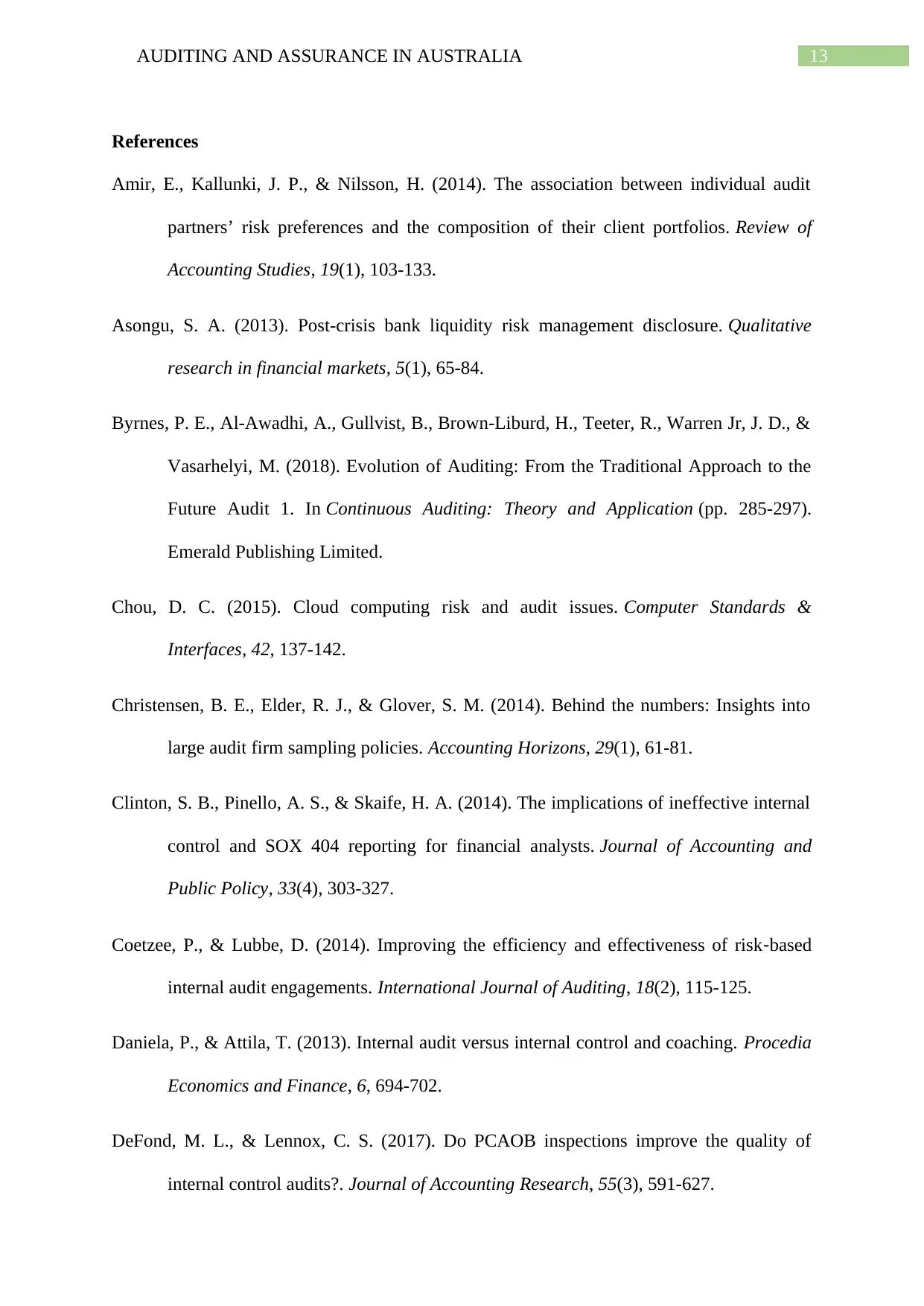
13AUDITING AND ASSURANCE IN AUSTRALIA
References
Amir, E., Kallunki, J. P., & Nilsson, H. (2014). The association between individual audit
partners’ risk preferences and the composition of their client portfolios. Review of
Accounting Studies, 19(1), 103-133.
Asongu, S. A. (2013). Post-crisis bank liquidity risk management disclosure. Qualitative
research in financial markets, 5(1), 65-84.
Byrnes, P. E., Al-Awadhi, A., Gullvist, B., Brown-Liburd, H., Teeter, R., Warren Jr, J. D., &
Vasarhelyi, M. (2018). Evolution of Auditing: From the Traditional Approach to the
Future Audit 1. In Continuous Auditing: Theory and Application (pp. 285-297).
Emerald Publishing Limited.
Chou, D. C. (2015). Cloud computing risk and audit issues. Computer Standards &
Interfaces, 42, 137-142.
Christensen, B. E., Elder, R. J., & Glover, S. M. (2014). Behind the numbers: Insights into
large audit firm sampling policies. Accounting Horizons, 29(1), 61-81.
Clinton, S. B., Pinello, A. S., & Skaife, H. A. (2014). The implications of ineffective internal
control and SOX 404 reporting for financial analysts. Journal of Accounting and
Public Policy, 33(4), 303-327.
Coetzee, P., & Lubbe, D. (2014). Improving the efficiency and effectiveness of risk‐based
internal audit engagements. International Journal of Auditing, 18(2), 115-125.
Daniela, P., & Attila, T. (2013). Internal audit versus internal control and coaching. Procedia
Economics and Finance, 6, 694-702.
DeFond, M. L., & Lennox, C. S. (2017). Do PCAOB inspections improve the quality of
internal control audits?. Journal of Accounting Research, 55(3), 591-627.
References
Amir, E., Kallunki, J. P., & Nilsson, H. (2014). The association between individual audit
partners’ risk preferences and the composition of their client portfolios. Review of
Accounting Studies, 19(1), 103-133.
Asongu, S. A. (2013). Post-crisis bank liquidity risk management disclosure. Qualitative
research in financial markets, 5(1), 65-84.
Byrnes, P. E., Al-Awadhi, A., Gullvist, B., Brown-Liburd, H., Teeter, R., Warren Jr, J. D., &
Vasarhelyi, M. (2018). Evolution of Auditing: From the Traditional Approach to the
Future Audit 1. In Continuous Auditing: Theory and Application (pp. 285-297).
Emerald Publishing Limited.
Chou, D. C. (2015). Cloud computing risk and audit issues. Computer Standards &
Interfaces, 42, 137-142.
Christensen, B. E., Elder, R. J., & Glover, S. M. (2014). Behind the numbers: Insights into
large audit firm sampling policies. Accounting Horizons, 29(1), 61-81.
Clinton, S. B., Pinello, A. S., & Skaife, H. A. (2014). The implications of ineffective internal
control and SOX 404 reporting for financial analysts. Journal of Accounting and
Public Policy, 33(4), 303-327.
Coetzee, P., & Lubbe, D. (2014). Improving the efficiency and effectiveness of risk‐based
internal audit engagements. International Journal of Auditing, 18(2), 115-125.
Daniela, P., & Attila, T. (2013). Internal audit versus internal control and coaching. Procedia
Economics and Finance, 6, 694-702.
DeFond, M. L., & Lennox, C. S. (2017). Do PCAOB inspections improve the quality of
internal control audits?. Journal of Accounting Research, 55(3), 591-627.
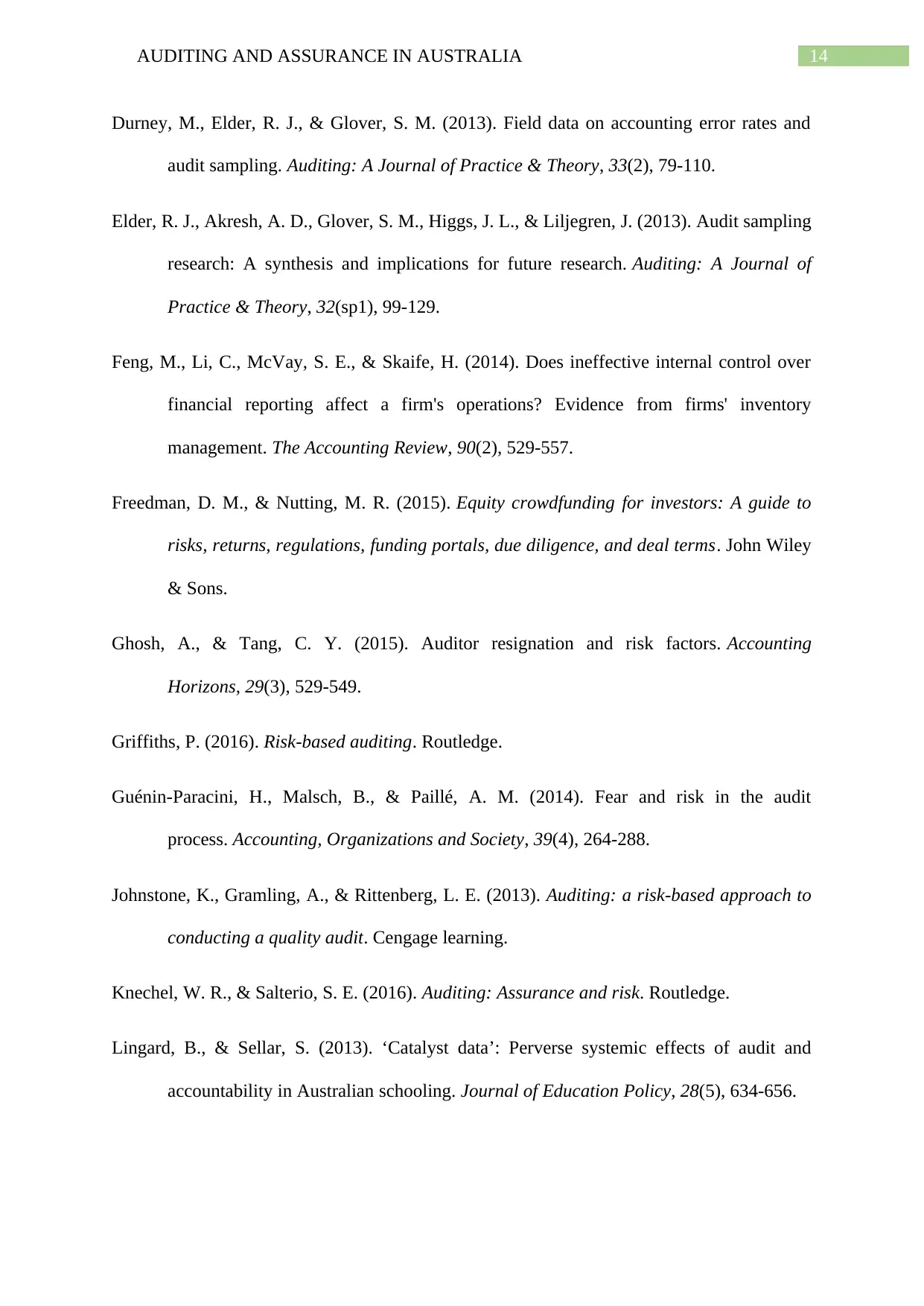
14AUDITING AND ASSURANCE IN AUSTRALIA
Durney, M., Elder, R. J., & Glover, S. M. (2013). Field data on accounting error rates and
audit sampling. Auditing: A Journal of Practice & Theory, 33(2), 79-110.
Elder, R. J., Akresh, A. D., Glover, S. M., Higgs, J. L., & Liljegren, J. (2013). Audit sampling
research: A synthesis and implications for future research. Auditing: A Journal of
Practice & Theory, 32(sp1), 99-129.
Feng, M., Li, C., McVay, S. E., & Skaife, H. (2014). Does ineffective internal control over
financial reporting affect a firm's operations? Evidence from firms' inventory
management. The Accounting Review, 90(2), 529-557.
Freedman, D. M., & Nutting, M. R. (2015). Equity crowdfunding for investors: A guide to
risks, returns, regulations, funding portals, due diligence, and deal terms. John Wiley
& Sons.
Ghosh, A., & Tang, C. Y. (2015). Auditor resignation and risk factors. Accounting
Horizons, 29(3), 529-549.
Griffiths, P. (2016). Risk-based auditing. Routledge.
Guénin-Paracini, H., Malsch, B., & Paillé, A. M. (2014). Fear and risk in the audit
process. Accounting, Organizations and Society, 39(4), 264-288.
Johnstone, K., Gramling, A., & Rittenberg, L. E. (2013). Auditing: a risk-based approach to
conducting a quality audit. Cengage learning.
Knechel, W. R., & Salterio, S. E. (2016). Auditing: Assurance and risk. Routledge.
Lingard, B., & Sellar, S. (2013). ‘Catalyst data’: Perverse systemic effects of audit and
accountability in Australian schooling. Journal of Education Policy, 28(5), 634-656.
Durney, M., Elder, R. J., & Glover, S. M. (2013). Field data on accounting error rates and
audit sampling. Auditing: A Journal of Practice & Theory, 33(2), 79-110.
Elder, R. J., Akresh, A. D., Glover, S. M., Higgs, J. L., & Liljegren, J. (2013). Audit sampling
research: A synthesis and implications for future research. Auditing: A Journal of
Practice & Theory, 32(sp1), 99-129.
Feng, M., Li, C., McVay, S. E., & Skaife, H. (2014). Does ineffective internal control over
financial reporting affect a firm's operations? Evidence from firms' inventory
management. The Accounting Review, 90(2), 529-557.
Freedman, D. M., & Nutting, M. R. (2015). Equity crowdfunding for investors: A guide to
risks, returns, regulations, funding portals, due diligence, and deal terms. John Wiley
& Sons.
Ghosh, A., & Tang, C. Y. (2015). Auditor resignation and risk factors. Accounting
Horizons, 29(3), 529-549.
Griffiths, P. (2016). Risk-based auditing. Routledge.
Guénin-Paracini, H., Malsch, B., & Paillé, A. M. (2014). Fear and risk in the audit
process. Accounting, Organizations and Society, 39(4), 264-288.
Johnstone, K., Gramling, A., & Rittenberg, L. E. (2013). Auditing: a risk-based approach to
conducting a quality audit. Cengage learning.
Knechel, W. R., & Salterio, S. E. (2016). Auditing: Assurance and risk. Routledge.
Lingard, B., & Sellar, S. (2013). ‘Catalyst data’: Perverse systemic effects of audit and
accountability in Australian schooling. Journal of Education Policy, 28(5), 634-656.
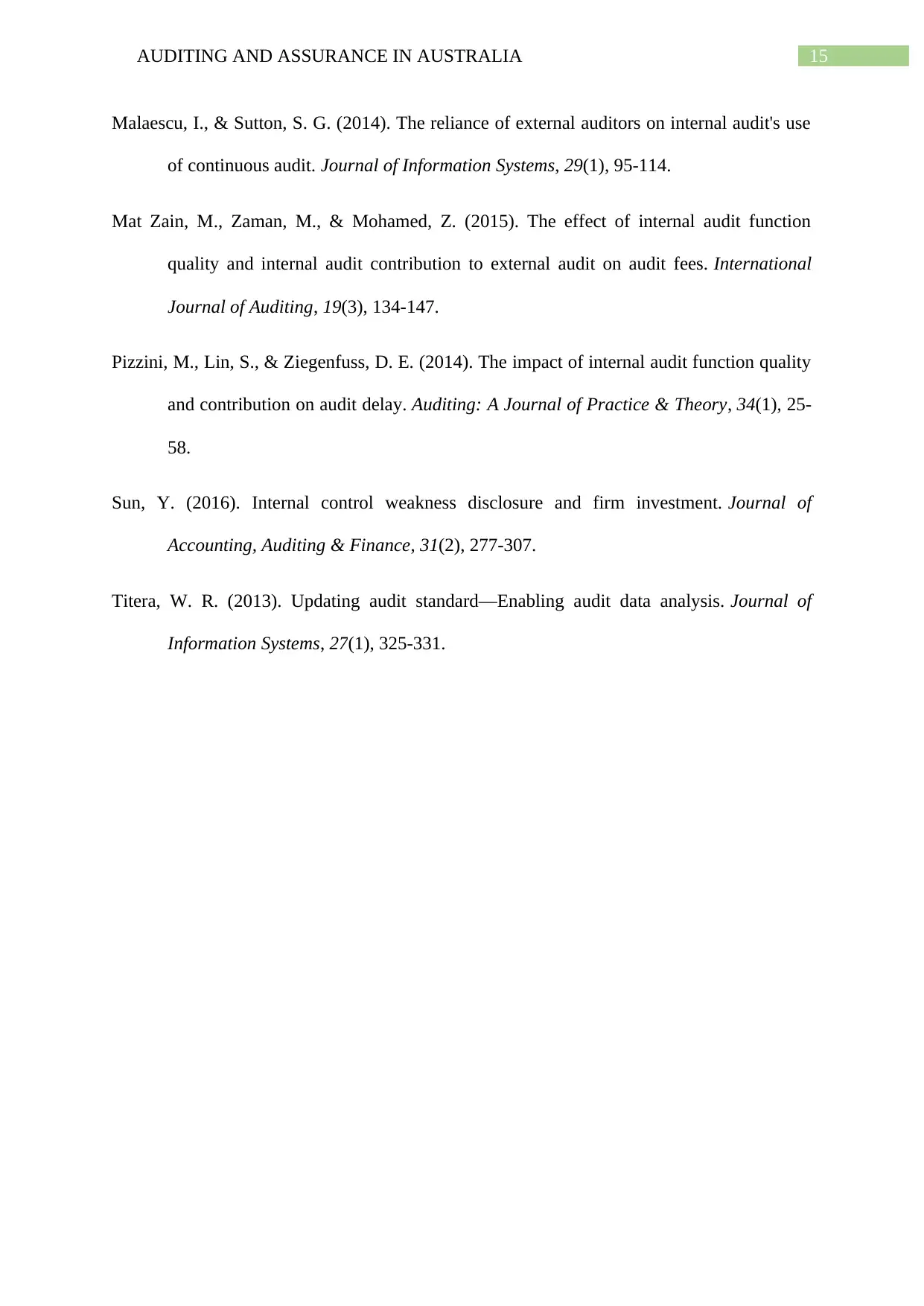
15AUDITING AND ASSURANCE IN AUSTRALIA
Malaescu, I., & Sutton, S. G. (2014). The reliance of external auditors on internal audit's use
of continuous audit. Journal of Information Systems, 29(1), 95-114.
Mat Zain, M., Zaman, M., & Mohamed, Z. (2015). The effect of internal audit function
quality and internal audit contribution to external audit on audit fees. International
Journal of Auditing, 19(3), 134-147.
Pizzini, M., Lin, S., & Ziegenfuss, D. E. (2014). The impact of internal audit function quality
and contribution on audit delay. Auditing: A Journal of Practice & Theory, 34(1), 25-
58.
Sun, Y. (2016). Internal control weakness disclosure and firm investment. Journal of
Accounting, Auditing & Finance, 31(2), 277-307.
Titera, W. R. (2013). Updating audit standard—Enabling audit data analysis. Journal of
Information Systems, 27(1), 325-331.
Malaescu, I., & Sutton, S. G. (2014). The reliance of external auditors on internal audit's use
of continuous audit. Journal of Information Systems, 29(1), 95-114.
Mat Zain, M., Zaman, M., & Mohamed, Z. (2015). The effect of internal audit function
quality and internal audit contribution to external audit on audit fees. International
Journal of Auditing, 19(3), 134-147.
Pizzini, M., Lin, S., & Ziegenfuss, D. E. (2014). The impact of internal audit function quality
and contribution on audit delay. Auditing: A Journal of Practice & Theory, 34(1), 25-
58.
Sun, Y. (2016). Internal control weakness disclosure and firm investment. Journal of
Accounting, Auditing & Finance, 31(2), 277-307.
Titera, W. R. (2013). Updating audit standard—Enabling audit data analysis. Journal of
Information Systems, 27(1), 325-331.
1 out of 16
Related Documents
Your All-in-One AI-Powered Toolkit for Academic Success.
+13062052269
info@desklib.com
Available 24*7 on WhatsApp / Email
![[object Object]](/_next/static/media/star-bottom.7253800d.svg)
Unlock your academic potential
© 2024 | Zucol Services PVT LTD | All rights reserved.





